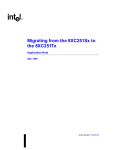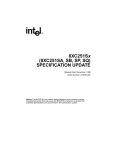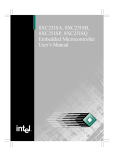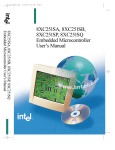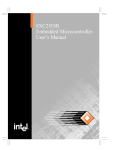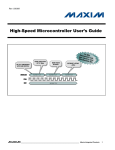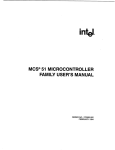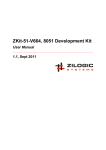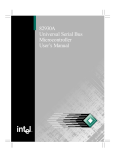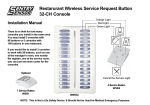Download Migrating from ZX2 to ZX3 Rev 1.0.bk
Transcript
Migrating from the 8XC251Sx to the 8XC251Tx Application Note December 2003 Order Number: 273252-002 Information in this document is provided in connection with Intel products. No license, express or implied, by estoppel or otherwise, to any intellectual property rights is granted by this document. Except as provided in Intel's Terms and Conditions of Sale for such products, Intel assumes no liability whatsoever, and Intel disclaims any express or implied warranty, relating to sale and/or use of Intel products including liability or warranties relating to fitness for a particular purpose, merchantability, or infringement of any patent, copyright or other intellectual property right. Intel products are not intended for use in medical, life saving, or life sustaining applications. Intel may make changes to specifications and product descriptions at any time, without notice. Designers must not rely on the absence or characteristics of any features or instructions marked "reserved" or "undefined." Intel reserves these for future definition and shall have no responsibility whatsoever for conflicts or incompatibilities arising from future changes to them. The 8XC251Sx and 8XC251Tx embedded microcontrollers may contain design defects or errors known as errata which may cause the product to deviate from published specifications. Current characterized errata are available on request. MPEG is an international standard for video compression/decompression promoted by ISO. Implementations of MPEG CODECs, or MPEG enabled platforms may require licenses from various entities, including Intel Corporation. Contact your local Intel sales office or your distributor to obtain the latest specifications and before placing your product order. Copies of documents which have an ordering number and are referenced in this document, or other Intel literature may be obtained by calling 1-800548-4725 or by visiting Intel's website at http://www.intel.com. Copyright © Intel Corporation, 2003 *Third-party brands and names are the property of their respective owners. Application Note Migrating from the 8XC251Sx to the 8XC251Tx Contents 1.0 Introduction ......................................................................................................................5 1.1 1.2 2.0 The Second Serial I/O Port ..............................................................................................6 2.1 2.2 2.3 3.0 References ............................................................................................................ 5 Comparing the 8XC251Sx and 8XC251Tx............................................................ 6 Overview ............................................................................................................... 6 Hardware Implications........................................................................................... 8 Software Implications ............................................................................................8 2.3.1 SCON1 ..................................................................................................... 9 2.3.2 SBUF1 .................................................................................................... 10 2.3.3 SADDR1 .................................................................................................10 2.3.4 SADEN1 .................................................................................................10 2.3.5 BGCON .................................................................................................. 10 2.3.6 IE1 .......................................................................................................... 11 2.3.7 IPH1 ....................................................................................................... 11 2.3.8 IPL1 ........................................................................................................11 Extended Data Float Timing ..........................................................................................12 3.1 Summary of the Extended Data Float Timing Changes ...................................... 12 1 2 3 4 5 Second Serial I/O Port Signals.............................................................................. 7 Second Serial I/O Port Special Function Registers ...............................................7 Second Serial I/O Priorities ................................................................................. 11 UCONFIG1 Bit Definitions for the 8XC251Tx...................................................... 12 Summary of the EDF# and WSB#[1:0] Configuration Options............................ 13 Tables Application Note 3 Migrating from the 8XC251Sx to the 8XC251Tx Revision History Date Revision Description May 1999 001 Initial release of this document December 2003 002 Removed references to 8XC251TA, 8XC251TP §§ 4 Application Note Migrating from the 8XC251Sx to the 8XC251Tx 6 Application Note Migrating from the 8XC251Sx to the 8XC251Tx 1.0 Introduction The 8XC251TB and TQ (referred to collectively as the 8XC251Tx) embedded microcontroller has joined the 8XC251SA, SB, SP, SQ (referred to collectively as the 8XC251Sx) as a member of the MCS 251 microcontroller family. The 8XC251Tx is pin and code compatible with the 8XC251Sx. It also has additional features that the 8XC251Sx does not possess. This document addresses the differences between the 8XC251Sx and the 8XC251Tx. It also addresses the implications of these differences for a user who is migrating from an existing 8XC251Sx design to an 8XC251Tx design. For a detailed description of the MCS 251 microcontroller core, and standard peripherals that are shared by both the 8XC251Sx and 8XC251Tx, please refer to the 8XC251SA, 8XC251SB, 8XC251SP, 8XC251SQ Embedded Microcontroller User’s Manual (order number 272795). 1.1 References Copies of documents which have an ordering number and are referenced in this document, or other Intel literature, may be obtained by calling 1-800-548-4725 or by visiting Intel’s website at http://www.intel.com. Title Intel Order Number 8XC251SA, 8XC251SB, 8XC251SP, 8XC251SQ Embedded Microcontroller User’s Manual 272795 8XC251SA, 8XC251SB, 8XC251SP, 8XC251SQ High-Performance CHMOS Microcontroller (Commercial/Express) Datasheet 272783 8XC251TB, 8XC251TQ Hardware Description 273138 8XC251TB, 8XC251TQ Datasheet 273129 AP-125, Designing Microcontroller Systems for Electrically Noisy Environments 210313 AP-155, Oscillators for Microcontrollers 230659 AP-708, Introducing the MCS® 251 Microcontroller—the 8XC251SB 272670 AP-709, Maximizing Performance Using MCS® 251 Microcontroller—Programming the 8XC251SB 272671 AP-710, Migrating from the MCS® 51 Microcontroller to the MCS 251 Microcontroller (8XC251SB)—Software and Hardware Considerations 272672 AP-70, Using the Intel MCS® 51 Boolean Processing Capabilities 203830 AP-223, 8051 Based CRT Terminal Controller 270032 AP-252, Designing With the 80C51BH 270068 AP-425, Small DC Motor Control 270622 AP-410, Enhanced Serial Port on the 83C51FA 270490 AP-415, 83C51FA/FB PCA Cookbook 270609 AP-476, How to Implement I C Serial Communcation Using Intel MCS 51 Microcontrollers 272319 2 Application Note 5 Migrating from the 8XC251Sx to the 8XC251Tx 1.2 Comparing the 8XC251Sx and 8XC251Tx This section presents an overview of the differences between the 8XC251Sx and the 8XC251Tx, and describes changes that an existing 8XC251Sx design would require to work with the 8XC251Tx. The differences between the 8XC251Tx and the 8XC251Sx are briefly described here. • The maximum operating frequency of the 8XC251Tx is 24 MHz. The maximum operating frequency of the 8XC251Sx is 16 MHz. To take advantage of the higher frequency available on the 8XC251Tx, the 16 MHz crystal on the 8XC251Sx design should be changed to a 24 MHz crystal. • The 8XC251Tx has two serial I/O ports, while the 8XC251Sx has one. The pins for the second serial I/O port are multiplexed with other functional pins. The hardware and software changes that are required to take advantage of the second serial port are discussed in detail in Section 2.0. • The 8XC251Tx has a new configuration option—Extended Data Float timing—that allows it to interface with slower memories. This feature is supported by a bit in the Configuration byte, UCONFIG1. The corresponding bit in the 8XC251Sx has a different function. The hardware and software changes that are required to take advantage of this feature are discussed in detail in Section 3.0 of this document. • The 8XC251Tx is offered with factory programmed ROM. The 8XC251Sx is offered with factory programmed ROM and OTPROM/EPROM. Software written for the 8XC251Sx will work for the 8XC251Tx. For 8XC251Tx development in which OTPROM devices are needed, an alternative is to use the 8XC251Sx OTPROM before porting the code to factory programmed ROM on the 8XC251Tx. However, if the second serial port or Extended Data Float timings are needed, using the 8XC251Sx OTPROM will not suffice. To address this need, third party vendors have been engaged to provide In-Circuit Emulators. 2.0 The Second Serial I/O Port The second serial I/O port is functionally the same as the standard serial I/O port that is shared by both the 8XC251Tx and the 8XC251Sx. This section provides information about the new special function registers (SFRs) that are associated with the second serial port. See Chapter 10 of the 8XC251SA, 8XC251SB, 8XC251SP, 8XC251SQ Embedded Microcontroller User’s Manual (Order Number 272795), for detailed information about the operation and programming of the serial I/O ports. All the SFRs and control bits for the standard serial I/O port have equivalent SFR’s and control bits in the second serial I/O port. Keep this in mind when reading Chapter 10 of the 8XC251SA, 8XC251SB, 8XC251SP, 8XC251SQ Embedded Microcontroller User’s Manual. 2.1 Overview The second serial I/O port provides synchronous and asynchronous communications modes. It operates as a universal asynchronous receiver and transmitter (UART) in three full-duplex modes (modes 1, 2 and 3). Asynchronous transmission and reception can occur simultaneously and at different baud rates. The second UART provides framing-bit error detection, multiprocessor communications, and automatic address recognition. The second serial port also operates in a single synchronous mode (mode 0). 6 Application Note Migrating from the 8XC251Sx to the 8XC251Tx The synchronous mode (mode 0) operates at a single baud rate. Mode 2 operates at two baud rates. Modes 1 and 3 operate over a wide range of frequencies, which are generated by timer 1 and timer 2. The second serial I/O port signals are defined in Table 1. The special function registers are described in Table 2. For the three asynchronous modes, the second serial I/O port transmits on the TXD1 pin and receives on the RXD1 pin. For the synchronous mode (mode 0), the second serial I/O port outputs a clock signal on the TXD1 pin and sends and receives messages on the RXD1 pin. The SBUF1 register holds received bytes and bytes that are to be transmitted. To send, software writes a byte to SBUF1; to receive, software reads SBUF1. The receive shift register allows reception of a second byte before the first byte has been read from SBUF1. However, if software has not read the first byte by the time the second byte is received, the second byte overwrites the first. The second serial I/O port sets interrupts bits TI1 and RI1 on transmission, and reception, respectively. These two share a single interrupt request and interrupt vector. The serial port control 1 (SCON1) and the secondary serial port control (BGCON) registers configures and controls the second serial I/O port. Table 1. Table 2. Second Serial I/O Port Signals Function Name Type TXD1 O RXD1 I/O Description Transmit Serial Data. TXD1 outputs the shift clock in serial I/O mode 0 and transmits serial data in serial I/O modes 1, 2 and 3 for the second serial I/O port. Receive Serial Data 1. RXD1 send and receives data in serial I/O mode 0 and receives data in serial I/O modes 1, 2 and 3 for the second serial I/O port. Multiplexed With P1.3/CEX0 P1.2/ECI Second Serial I/O Port Special Function Registers (Sheet 1 of 2) Application Note Mnemonic Description Address SBUF1 Serial Buffer 1. Two separate registers comprise the SBUF1 register. Writing to SBUF1 loads the transmit buffer; reading SBUF1 access the receive buffer. 9BH SCON1 Serial Port Control 1. Selects the second serial I/O port operating mode. SCON1 enables and disables the receiver, framing bit error detection, multiprocessor communication, automatic address recognition and the serial port interrupt bits. 9AH SADDR1 Serial Address 1. Defines the individual address for a slave device. AAH SADEN1 Serial Address Enable 1. Specifies the mask byte that is used to define the given address for a slave device. BAH BGCON Secondary Serial Port Control. Contains controls to the second serial port including the double baud rate bit, read/write access to the SCON1.7 bit as well as bits to control timer1 or 2 overflow as the baud rate generator for reception and transmission. 8FH 7 Migrating from the 8XC251Sx to the 8XC251Tx Table 2. Second Serial I/O Port Special Function Registers (Sheet 2 of 2) Mnemonic Description Address IE1 Interrupt Enable Register 1. Contains the second serial I/O port interrupt enable bit. B1H IPL0 Interrupt Priority Low Control Register 1. IPL0, together with IPH0, assigns the second serial I/O port interrupt level from 0 (lowest) to 3 (highest). B2H IPH0 Interrupt Priority High Control Register 1. IPH0, together with IPL0, assigns the second serial I/O port interrupt level from 0 (lowest) to 3 (highest). B3H The second serial I/O port interrupt is enabled by setting the ES1 bit in the IE1 register. The priority of the second serial I/O port’s interrupt is set to one of four levels by programming the IPL1.0 and IPH1.0 bits in the IPL1 and IPH1 registers respectively. The second serial I/O port is last in the interrupt polling sequence. See Chapter 6 of the 8XC251SA, 8XC251SB, 8XC251SP, 8XC251SQ Embedded Microcontroller User’s Manual (Order Number 272795) for details of the interrupt system. 2.2 Hardware Implications When the second serial I/O port is used, the alternate functions of RXD1 and TXD1 can no longer be used. Specifically, the PCA can no longer be clocked by an external clock input, because ECI now functions as RXD1. The PCA can, however, be clocked by one of three other methods. These are: two fixed frequencies (fixed in relation to the Oscillator frequency); Fosc/12 and Fosc/4 and Timer 0 overflow. The other consequence of using the second serial I/O port, is Module 0 of the PCA can now be used only as a 16-bit Software Timer. The 16-bit Capture, High Speed Output, and Pulse Width Modulation modes are no longer available to Module 0, since these modes require the use of CEX0 (CEX0 functions as TXD1 when the second serial I/O port is in operation). 2.3 Software Implications As described earlier, the second serial port is functionally equivalent to the standard serial port. Because of this, programming remains the same. The following sections describe the special function registers that are associated with the second serial I/O port and their bit definitions. 8 Application Note Migrating from the 8XC251Sx to the 8XC251Tx 2.3.1 SCON1 Address: 9AH Reset Value: 0000 0000B Bit Number Bit Mnemonic FE1 7 Function Framing Error Bit 1: To Select this function, set the SMOD0 bit in the BGCON register. Set by hardware to indicate an invalid stop bit. Cleared by software, not by valid frames. Second Serial I/O Port Mode Bit 0: SM0 To select this function, clear the SMOD0 bit in the BGCON register. Software writes to bit SM0 and SM1 to select the second serial I/O port operating mode. Refer to SM1 bit for mode selections. Second Serial I/O Port Mode Bit 1: 6 SM1 Software write to bit SM0 and SM1 (above) to select the serial port operating mode. SM0 SM1 Mode Description Baud Rate 0 0 0 Shift Register Fosc/12 0 1 1 8 bit UART variable 1 0 2 9 bit UART Fosc/32* or Fosc/64* 1 1 3 9 bit UART variable * Select by programming the SMOD0 bit in the BGCON register. Second Serial I/O Port Mode Bit 2: 5 SM2 4 REN1 3 TB8 Software writes to SM2 enable and disable the multiprocessor communication and automatic address recognition features. This allows the second serial I/O port to differentiate between data and command frames and to recognize slave and broadcast addresses. Receive Enable Bit 1: To enable reception, set this bit. To enable transmission, clear this bit. Transmit Bit 8: In modes 2 and 3, software writes the ninth data bit to be transmitted to TB8. Not used in modes 0 and 1. Receive Bit 8: Mode 0: not used. 2 RB8 Mode 1 (SM2 clear): Set or cleared by hardware to reflect the stop bit received. Modes 2 and 3 (SM2 set): Set or cleared by hardware to reflect the ninth data bit received. 1 TI1 0 RI1 Second Serial I/O Port Transmit Interrupt Flag Bit: Set by transmitter after the last data bit is transmitted. Cleared by software. Second Serial I/O Port Receive Interrupt Flag Bit: Application Note Set by the receiver after the last data bit of a frame has been received. Cleared by software. 9 Migrating from the 8XC251Sx to the 8XC251Tx 2.3.2 SBUF1 Address: 9BH Reset Value: xxxx xxxxB To send serial data, software writes a byte to SBUF1. To receive serial data, software reads from SBUF1. 2.3.3 SADDR1 Address: AAH Reset Value: 0000 0000B Slave Individual Address Register1 (SADDR1) contains the device’s individual address for multiprocessor communications. 2.3.4 SADEN1 Address: BAH Reset Value: 0000 0000B Mask Byte Register 1 (SADEN1) masks bits in the SADDR1 register to form the device’s given address for multiprocessor communications. 2.3.5 BGCON Address: 8FH Reset Value: 0000 xxxxB Bit Number Bit Mnemonic 7 SMOD1 6 SMOD0 Function Double Baud Rate Bit: When set, doubles the baud rate for the second serial I/O port when timer 1 is used and mode 1, 2 or 3 is selected in the SCON1 register. SCON1.7 Select: When set, read/write accesses to SCON1.7 are to the FE1 bit. When cleared, read/write accesses to SCON1.7 are to the SM0 bit. Second Serial I/O Port Receive Clock Bit: 5 RCLK1 4 TCLK1 3-0 - Selects timer 2 overflow pulses (RCLK1 = 1) or timer 1 overflow pulses (RCLK1 = 0) as the baud rate generator for the serial port modes 1 and 3. Second Serial I/O Port Transmit Clock Bit: 10 Selects timer 2 overflow pulses (TCLK = 1) or timer 1 overflow pulses (TCLK1 = 0) as the baud rate generator for the serial port modes 1 and 3. Reserved Application Note Migrating from the 8XC251Sx to the 8XC251Tx 2.3.6 IE1 Address: B1H Reset Value: xxxx xxx0B 2.3.7 Bit Number Bit Mnemonic 7-1 - 0 ES1 Function Reserved Second Serial I/O Port Interrupt Enable: Setting this bit enables the second serial I/O port interrupt. IPH1 Address: B3H Reset Value: xxxx xxx0B Bit Number Bit Mnemonic 7-1 - 0 IPH1.0 Function Reserved Second Serial I/O Port Interrupt Priority High Bit: 2.3.8 Interrupt priority of the second serial I/O port can be programmed to one of four levels, depending on the IPH1.0 and IPL1.0 bits. See Table 3. IPL1 Address: B2H Reset Value: xxxx xxx0B Bit Number Bit Mnemonic 7-1 - Function Reserved Second Serial I/O Port Interrupt Priority Low Bit: 0 Table 3. IPL1.0 Interrupt priority of the second serial I/O port can be programmed to one of four levels, depending on the IPH1.0 and IPL1.0 bits. See Table 3. Second Serial I/O Priorities Application Note IPH1.0 IPL1.0 Priority Level 0 0 0 (Lowest Priority) 0 1 1 1 0 2 1 1 3 (Highest Priority) 11 Migrating from the 8XC251Sx to the 8XC251Tx 3.0 Extended Data Float Timing The Extended Data Float Timing feature provides a solution for users who may be using slower memory devices. Essentially, this feature extends the TRHDZ1 AC timing specification to accommodate slower memory devices, which require a longer period of dead time between data bus cycles and address bus cycles. This feature is controlled by a bit in the Configuration byte (UCONFIG1). Bit 3 of UCONFIG1 in the 8XC251Tx is defined as EDF#. In the 8XC251Sx, Bit 3 is defined as WSB. The implications of this change are discussed below. For details of the device configuration for the 8XC251Sx, refer to Chapter 4 of the 8XC251SA, 8XC251SB, 8XC251SP, 8XC251SQ Embedded Microcontroller User’s Manual (Order Number 272795). The information in that chapter is valid for the 8XC251Tx, with the exception of the change noted in this section. 3.1 Summary of the Extended Data Float Timing Changes EDF# is used to determine when the Extended Data Float Timing is enabled. Table 4 shows the definition of UCONFIG1 for the 8XC251Tx. Only bit 3 has been redefined. Table 4. UCONFIG1 Bit Definitions for the 8XC251Tx Bit Number Bit Mnemonic Function 7:5 - Reserved for internal or future use. Set these bits when programming UCONFIG1. Interrupt Mode: 4 INTR 3 EDF# When this bit is set, interrupts push 4 bytes onto the stack (the 3 bytes of the PC and PSW1). When this bit is clear, interrupts push the 2 lower bytes of the PC onto the stack. Extended Data Float Timings: When cleared, the extended data float timings are enabled. When set, 8XC251Sx compatible AC timings are enabled. External Wait State B (region 01:): WSB1# WSB2# 2:1 WSB1:0# 0 0 Inserts 3 wait states for region 01: 0 1 Inserts 2 wait states for region 01: 1 0 Inserts 1 wait state for region 01: 1 1 Zero wait states for region 01: EPROM Map: 0 EMAP For devices with 16 Kbytes of on-chip code memory, clear this bit to map the upper half of the on-chip code memory to region 00: (data memory). Maps FF:2000H-FF:3FFFH to 00:E000H-00:FFFFH. When this bit is set, mapping does not occur and the addresses in the range 00:E000H00:FFFFH access external RAM. Refer to the 8XC251TB, 8XC251TQ Datasheet (order number 273129) for the AC timings specifications. 12 Application Note Migrating from the 8XC251Sx to the 8XC251Tx Table 5 shows the effect of programming EDF# and WSB#[1:0] on the extended data float timing feature. It also shows the insertion of wait states for region 01:. Note that enabling the extended data float timing allows region 01: to have 1 or 3 wait states inserted (depending on WSB#[1:0]), but not 0 or 2 wait states. Table 5. Summary of the EDF# and WSB#[1:0] Configuration Options EDF# WSB#[1:0] Wait State Extended Data Float Timings 1 11 0 No 1 10 1 No 1 01 2 No 1 00 3 No 0 11 1 Yes 0 10 1 Yes 0 01 3 Yes 0 00 3 Yes The external user configuration cycle (UCONF = 1 and EA# = 0) will be executed with the extended TRHDZ1 timing bus cycle. Application Note 13
















